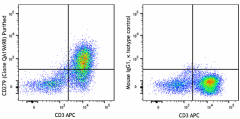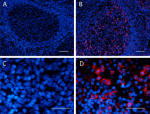- Clone
- QA19A98 (See other available formats)
- Regulatory Status
- RUO
- Other Names
- PD-1, PDCD1
- Isotype
- Mouse IgG1, κ
- Ave. Rating
- Submit a Review
- Product Citations
- publications

-

PHA-stimulated (3 days) human peripheral blood mononuclear lymphocytes were stained with purified anti-human CD279 (PD-1) recombinant (clone QA19A98) (left) or mouse IgG1, κ isotype control (right) followed by anti-mouse IgG PE. Cells were then co-stained with CD3 APC. -

IHC staining of purified anti-human CD279 (clone QA19A98) on formalin-fixed paraffin-embedded human tonsil tissue. Following antigen retrieval using 1X Tris-Buffered Saline (final concentration 0.05M) with Tween 20 (Cat. No. 925501) the tissue was incubated with blocking buffer. Tissue was then stained without (panel A) or with 10 µg/mL of primary antibody (panel B) overnight at 4°C, followed by incubation with 2.5 µg/mL of Alexa Fluor® 647 goat anti-mouse IgG (Cat. No. 405322) for one hour at room temperature. Nuclei were counterstained with DAPI (blue) (Cat. No. 422801) and images were captured with 10X (panels A and B) and 40X (panels C and D) objectives. Scale bar: 50 µm
| Cat # | Size | Price | Quantity Check Availability | Save | ||
|---|---|---|---|---|---|---|
| 322102 | 100 µg | $89 | ||||
Programmed cell death protein 1 (PD-1), also known as CD279, is a 55 kD member of the immunoglobulin superfamily. CD279 contains the immunoreceptor tyrosine-based inhibitory motif (ITIM) in the cytoplasmic region and plays a key role in peripheral tolerance and autoimmune disease. CD279 is expressed predominantly on activated T cells, B cells, and myeloid cells. PD-L1 (B7-H1, CD274) and PD-L2 (B7-DC, CD273) are ligands of CD279 (PD-1) and are members of the B7 gene family. Evidence suggests overlapping functions for these two PD-1 ligands and their constitutive expression on some normal tissues and upregulation on activated antigen-presenting cells. Interaction of CD279 ligands results in inhibition of T cell proliferation and cytokine secretion.
Product DetailsProduct Details
- Verified Reactivity
- Human
- Antibody Type
- Recombinant
- Host Species
- Mouse
- Immunogen
- Human CD279
- Formulation
- Phosphate-buffered solution, pH 7.2, containing 0.09% sodium azide
- Preparation
- The antibody was purified by affinity chromatography.
- Concentration
- 0.5 mg/mL
- Storage & Handling
- The antibody solution should be stored undiluted between 2°C and 8°C.
- Application
-
FC - Quality tested
IHC-P - Verified - Recommended Usage
-
Each lot of this antibody is quality control tested by immunofluorescent staining with flow cytometric analysis. For flow cytometric staining, the suggested use of this reagent is ≤ 0.25 µg per million cells in 100 µL volume. For immunohistochemistry on formalin-fixed paraffin-embedded tissue sections, a concentration range of 5 - 10 µg/mL is suggested. It is recommended that the reagent be titrated for optimal performance for each application.
- Application Notes
-
Clone QA19A98 antibody is able to completely block binding of clone A17188B on target cells.
This recombinant antibody clone is derived from clone A17188B. - RRID
-
AB_2890754 (BioLegend Cat. No. 322102)
Antigen Details
- Structure
- 55 kD type 1 transmembrane protein
- Distribution
-
Transiently expressed on CD4- and CD8- thymocytes, upregulated in thymocytes and splenic T and B lymphocytes, and is expressed on activated myeloid cells
- Function
- Signaling, co-stimulation, co-inhibition
- Interaction
- SHP-1 and SHP-2
- Ligand/Receptor
- PD-L1 (CD274) and PD-L2 (CD273)
- Cell Type
- Lymphocytes, T cells
- Biology Area
- Cell Biology, Immuno-Oncology, Immunology, Inhibitory Molecules
- Molecular Family
- CD Molecules, Immune Checkpoint Receptors
- Antigen References
-
1. Francisco LM, Sage PT, and Sharpe AH. 2010. Immunological Rev. 236:219
- Gene ID
- 5133 View all products for this Gene ID
- UniProt
- View information about CD279 on UniProt.org
Related FAQs
Other Formats
View All CD279 Reagents Request Custom Conjugation| Description | Clone | Applications |
|---|---|---|
| Purified anti-human CD279 (PD-1) Recombinant Antibody | QA19A98 | FC,IHC-P |
Compare Data Across All Formats
This data display is provided for general comparisons between formats.
Your actual data may vary due to variations in samples, target cells, instruments and their settings, staining conditions, and other factors.
If you need assistance with selecting the best format contact our expert technical support team.
-
Purified anti-human CD279 (PD-1) Recombinant Antibody

PHA-stimulated (3 days) human peripheral blood mononuclear l... 
IHC staining of purified anti-human CD279 (clone QA19A98) on...
 Login/Register
Login/Register 








Follow Us